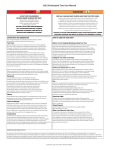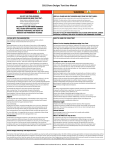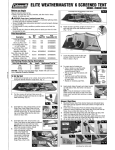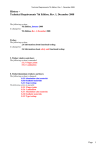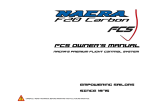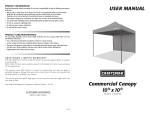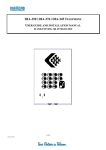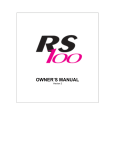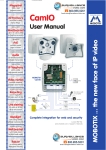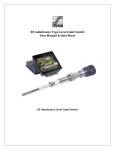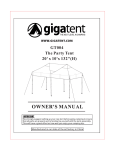Transcript
2010 Slumberjack Tent User Manual DANGER DO NOT USE FUEL-BURNING DEVICES INSIDE OR NEAR THIS TENT. Stoves, lanterns, candles, grills, heaters and other fuel burning devices produce carbon monoxide and will consume the available oxygen in this tent. FAILURE TO FOLLOW THESE WARNINGS WILL CAUSE ASPHYXIATION, CARBON MONOXIDE POISONING, AND DEATH OR SERIOUS AND PERMANENT INJURIES COPING WITH THE UNEXPECTED Even though Slumberjack uses only the best quality materials, accidents and normal wear and tear do take their toll on your tent. Tent Poles Before pitching your tent, be sure all sections of your poles are fully engaged at their joints. Gaps at section joints will expose the pole’s joints to forces for which they were not intended. This can cause them to bend or break. Tent pole joints are sufficiently strong for their function, but only when they are fully joined and connected with their mating tube sections. While assembling or folding your poles, be sure not to allow a pole’s sections to snap against one another as the impact can cause damage to the ends and stress fractures. Try to avoid stepping on or striking your poles on rocks during setup. Since pole damage most frequently occurs during pitching or when horseplay occurs around the tent, be sure not to bend your poles into tighter curves than they naturally assume in the tent – take extra caution in high wind situations. Excessive bending or distortion of the poles can occur in a free-standing tent if it is picked up by only one of its poles while moving the tent. Move a free-standing tent by grasping it at the pole intersections. Proper care of poles includes keeping poles clean and free of dirt and salt. Always rinse poles with fresh water if exposed to salt water or after coastal camping. Occasional lubrication of the section joints with silicone spray will help the joints slide together freely and will ward off ice-forming problems in snow. Shockcord Your Slumberjack tent poles are assembled with extreme weather shockcord – the only elastic cord created especially to withstand the rigors of serious backpacking/ camping use. Keeping your poles in a fully, or even a partially extended position during long-term storage will relieve the tension on the elastic cord and help to insure maximum performance and reliability. When folding your poles, be sure to fold from the center out so as not to place uneven tension on the elastic cord. Occasionally the shockcord in your poles may break, pull out of the pole, or just go limp. This is not a disaster, the pole is still perfectly functional, the tension on the pole when it is set in place on the tent will keep it together. Finish your trip and return the pole to the Slumberjack Warranty Department at your leisure for repair. Zippers Always be gentle when operating zippers, avoid standing on them and try to limit exposing them to dirt and grit. Taking these precautions combined with frequent cleaning will protect them against premature failure. Tears and Damage Despite your best efforts, sometimes damage does occur to your tent. Waterproof self-adhesive repair tape is sold at many outdoor stores and several pieces can be tucked into the tent bag without adding any appreciable weight. Urethane based seam sealing products can be used to plug small holes and duct tape works as well for minor field repair. It’s a good idea to carry one or a combination of these things with your tent in the event the tent is damaged while in use. Condensation Condensation is the build-up of moisture on the inside of your rainfly and tent walls due to a temperature difference between the inside and outside of your tent. Condensation occurs mostly when the conditions are cold, rainy, or humid, although it can occur at any time. The best way to minimize condensation is to increase the ventilation within your tent and between the tent body and fly. Completely guying out the rainfly often helps, as does leaving the vestibule door open as much as possible. WARNING KEEP ALL FLAME AND HEAT SOURCES AWAY FROM THIS TENT FABRIC. This tent is made with flame resistant fabric which meets CPAI-84 specifications. IT IS NOT FIREPROOF. The fabric will burn if left in continuous contact with any flame source. The application of any foreign substance to the tent fabric may render the flame-resistant properties ineffective. This tent must be properly ventilated in all weather conditions. For example, snow could obstruct airflow and cause asphyxiation unless cleared frequently. NEVER leave children unattended inside a tent. Anchor your tent securely to provide additional security from changing climatic conditions. Snow pegs, skis and/or heavy rocks may be necessary to supplement tent stakes and guy cords. FAILURE TO FOLLOW THESE WARNINGS COULD CAUSE ASPHYXIATION, CARBON MONOXIDE POISONING, AND DEATH OR SERIOUS AND PERMANENT INJURIES. HOW TO CARE FOR YOUR TENT Before You Go Camping: Weatherproofing Your Tent The rainfly and center floor seam (if applicable) of your tent have been taped at the factory. While seam tape significantly increases the weatherproofness of your tent, additional seam sealing will improve the performance of your tent in rainy conditions. For additional weatherproofness, seal all places where attachments are sewn to the fly, including webbing, Velcro, snaps, guy-outs, and zipper tracks. The best way to seal your tent is to use a urethane-based seam sealer and run a thin bead around the base of the attachment, where it is sewn to the fly. Do this to attachments both on the inside and the outside of the tent. Caring for Your Tent on the Trail It is important to select a site which has been cleared of any sharp objects such as rocks or sticks. Many people prefer to use ground sheets under the tent for additional protection. If you choose to do so, make sure the floor of the tent completely covers the ground sheet, or else the sheet will collect rain. Tent Footprints are now available for all current Slumberjack tents. Staking and Guying Out Your Tent Most Slumberjack tents are free-standing, not requiring the use of stakes in order to pitch the tent. This is a matter of convenience, allowing quick set-up and easy moving and cleaning of the tent. All tents, free-standing or not, must be staked out properly in order to achieve full structural integrity and prevent wind damage. No lightweight, back-packing style tent, whether rated at 3-season or 4-season, is capable of withstanding strong wind gusts without damage unless anchored and guyed properly. See the specific instructions for your tent for guidance on these procedures. Guying out your tent can increase rain protection and ventilation and greatly enhance wind resistance. Fire Your tent is constructed of flame-retardant materials, however this material will melt or burn if exposed to sufficient heat or open flame. Use prudence in positioning your tent near campfires, stoves, barbecues, etc. Caution: Slumberjack is absolutely against cooking inside a tent. Asphyxiation, severe or even fatal burns are possible if a stove is used in a tent or vestibule without adequate ventilation. Additionally, a hot stove can melt through your tent floor if the stove is not rigorously insulated; and pots of hot liquid, if left uncovered, may create a condensation ridden tent. Ultraviolet Light UV light is one of the most damaging of all the elements. When exposed to prolonged and extensive sunlight most fabrics will fade, lose strength, and eventually break down. Try to minimize exposing your tent to the sun. Store it during the day or pitch it in shady areas. Animal Hazards Animal damage to tents is all too common, but is usually easily avoidable: Never store food in your tent! What to Do When the Trip’s Over It is important to dry your tent completely before returning it to its stuff sack. If stored wet, mildew will occur in untreated areas. Mildew damage is not covered under warranty. Hand wash your tent with a mild soap and a sponge. Do not use harsh detergents, chemicals, or abrasive materials. Dirt particles left in the weave of the material speed up the deterioration of the fabric. Clean tents last longer. Never machine-wash your tent!! Over extended periods, store your tent loosely, out of the bag in a cool, dry environment. Wenger Warranty and Repair Service We maintain a full repair facility to assist you with any problems you may have with any Slumberjack tent product. We offer a limited lifetime warranty against defects in materials and workmanship, and for a nominal charge we will repair damage due to accidents or normal wear and tear. This warranty does not cover damages caused by improper care, accidents, or the natural breakdown of materials over extended use and time. State Law requires all items returned for repair must be clean. Wenger does not wash tents! Dirty tents will be returned to sender for cleaning. You may contact the Warranty and Repair Department with comments or questions at the address below or by calling (800)233-6283 during regular business hours, mountain time zone.
